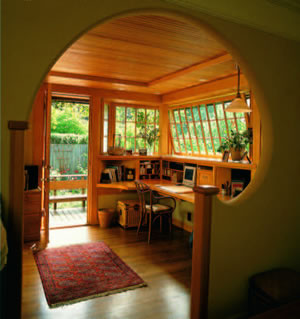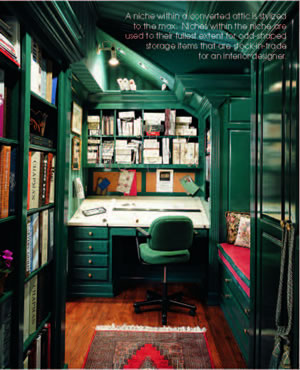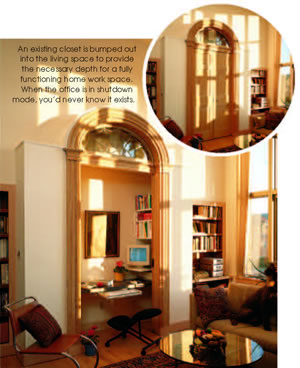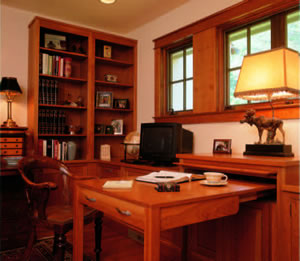Creating the Ideal Home Workspace
Text and Photos adapted from Taunton's Home Workspace Idea Book by Neal Zimmerman
With an estimated 50 million people now working at home, an awareness has emerged that the quality of the home workplace counts - not only for efficiency, comfort, and safety, but for the sheer pleasure of being there.
Creating a space where you can get work done productively and spend your time peacefully and joyously, requires three basic planning principles:
(1) taking stock of your needs,
(2) evaluating and choosing a location and
(3) developing a home workplace that helps you balance your work style and home life.
ASSESSING YOUR NEEDS
As a starting point for assessing space needs, I've developed an acronym that many people have found helpful. I call it "CAMP."
"C" is for Computer stations, one or more of which will be found in virtually every home workplace today, no matter what type of work you do.
"A" stands for the Administrative station - the place where you open your mail, pay bills, prepare packages for mailing, and perhaps take telephone calls.
"M" is the Meeting station, which may vary from none at all to a significant-size conference table.
"P" stands for Project station, which is the most variable type in size, equipment, and number. Clearly, a floral arranger will need a different project station than a woodworker, a fine artist, or a computer-software designer will require.
Not everyone will need all four station types and the stations don't all have to be in one contiguous space. To predict storage needs, take an inventory of all records, supplies, perhaps even products and determine a rough calculation of how much space you require.
The next step in creating the ideal home workspace is to divide the items to be stored into Active and Inactive categories. Active storage will contain materials you need access to on a regular basis, such as documents, files and supplies and should be readily accessible to the workstation. Inactive storage is for stuff you'll occasionally need to access, like bulk supplies, completed client records, or reference books, which is best located elsewhere in the home.
Before proceeding, it is imperative to thoroughly investigate local ordinances; you may be required to apply for a permit to work at home. There may also be zoning restrictions prohibiting receiving frequent visitors or having other employees working within your home.

The arched opening between this writing room and an adjoining bedroom is shaped like a wave or shell, reflecting the owner's love of the sea.

A niche within a converted attic is stylized to the max. Niches within the niche are used to their fullest extent for odd-shaped storage items that are stock-in-trade for an interior designer.

An existing closet is bumped out into the living space to provide the necessary depth for a fully functioning home work space. When the office is in shutdown mode, you'd never know it exists.

In a space where work and domestic life coexist, it's great to be able to hide things away when you switch out of full work mode. Here, a work surface on wheels tucks away neatly into a cabinet and keyboard and printer can be concealed behind cabinet doors.
CHOOSING YOUR LOCATION
Selecting the best setting for your home workspace is very important to its success. Consider how much privacy you require and how you will protect your space and its contents from marauding family members (and pets).
If you expect to have visitors or staff, you'll somehow need to develop separation between business traffic and family living space.
Converted attics, sunrooms, spare bedrooms, dens and segregated basement areas offer optimal privacy. Alcoves, hallways, mid-level landings and lofts are by nature separated from main activity areas. Workspaces in niche spaces and closets can be protected by sliding doors.
If your space is in a shared area of a bedroom, dining room or a delegated area of a family room, it is helpful to set a boundary using a folding screen, curtains or blinds, a half wall or a bookcase used as a divider. If clients will be coming and going, a separate entrance is highly desirable, along with an appropriate meeting area and a nearby restroom.
DEVELOPING YOUR HOME WORKSPACE
The first step after determining space needs and a location is to sketch a floor plan. Success in developing a floor plan will require a very accurate background plan (a scale drawing of the area including doors, windows, radiators, electrical outlets and switches, etc.) as well as a thorough knowledge of your workstation, equipment, and storage needs.
You might even generate two or three alternate plans to see which one works the best. After deciding on the preferred layout, you can then think about your power requirements - where you'll
need to introduce outlets, phone jacks, and so on. Ensuring your space will be comfortable requires thinking about lighting, views and comfortable seating and ergonomic tools.
Natural light is desirable in a home workplace because it provides a view and a connection to the outdoors. Although it is often used, recessed ambient lighting can accelerate eye fatigue because the light source is too far from the surface and tends to throw shadows. Task lighting is a better choice. The two most common forms are strip fluorescent and halogen lamps with flexible arms.
The last, and in some ways most important, topic to address is designing a place for Who You Are. Without a distinctive personality, a home workplace might just as well be anybody's.
Working at home offers you the opportunity to personalize your environment in a way that would be impossible in the traditional workplace. The environment you create, yours to organize and decorate as you wish, should be a reflection of your personality.
The more successful you are in translating the space that you choose into a place for who you are, the more successful your home workplace will be.
With careful thought in assessing your needs, choosing a location, and developing a comfortable space which fits your personality, you'll be able to create the ideal home workspace that becomes a place you gravitate toward, rather than just go.

